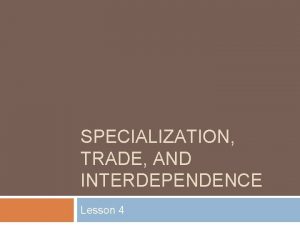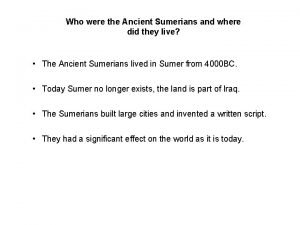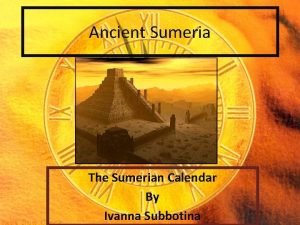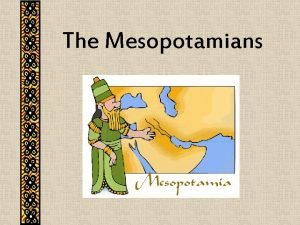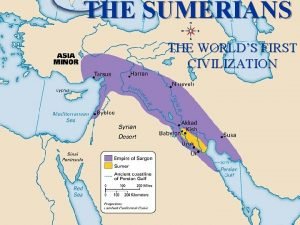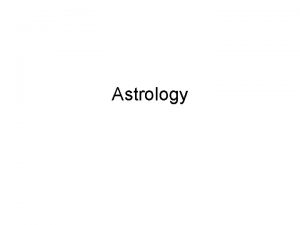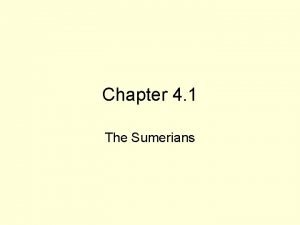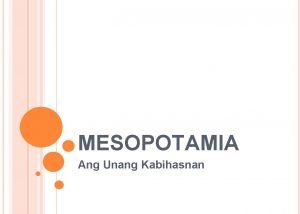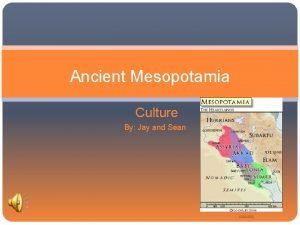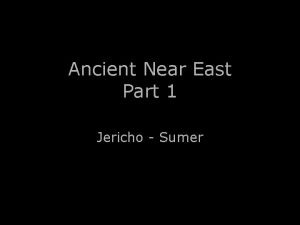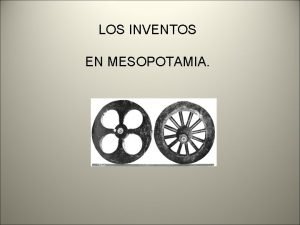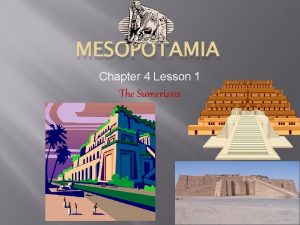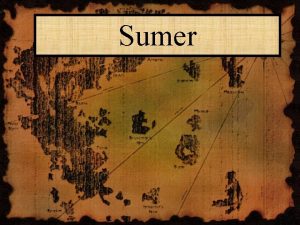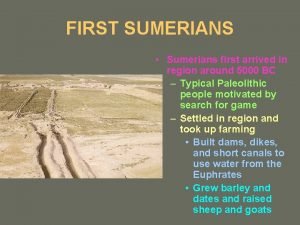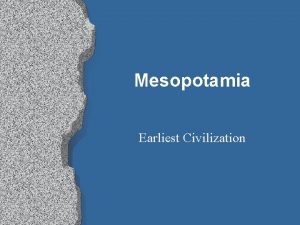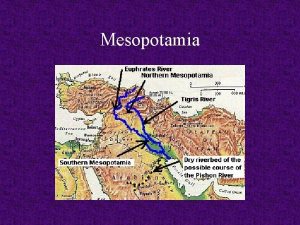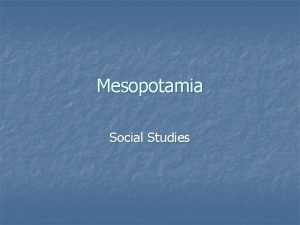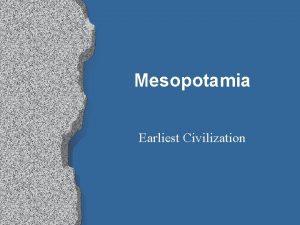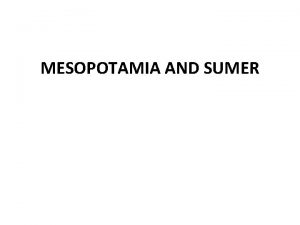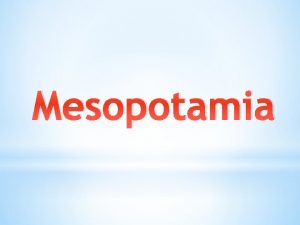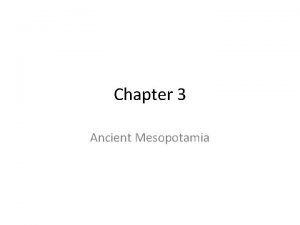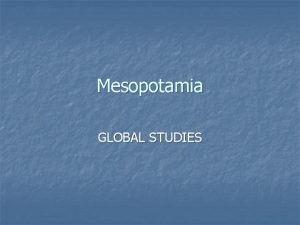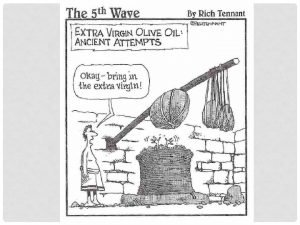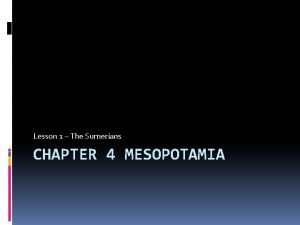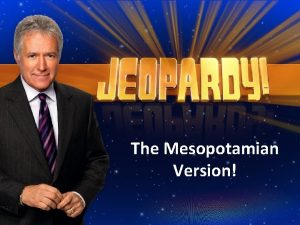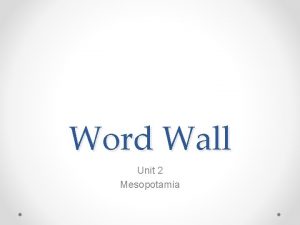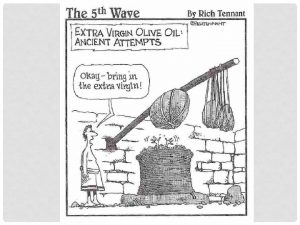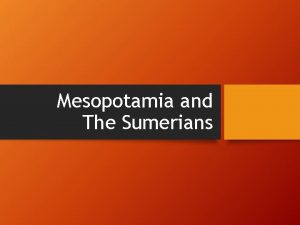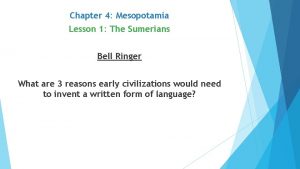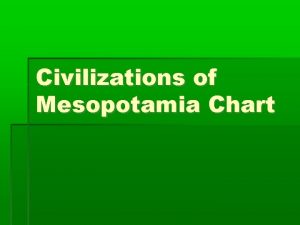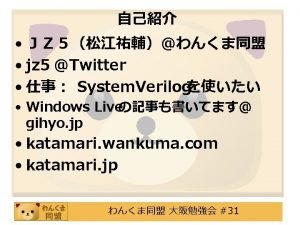The Sumerians Mesopotamia n n n Live in



























































- Slides: 59

The Sumerians

Mesopotamia n n n Live in fertile valleys Mesopotamia means “between the rivers” Tigris and Euphrates

Beginnings of Sumer Called “the black-headed people” n Origins not entirely known n Dominated Semitic-speaking neighbors, leading to building of a civilization n

City-States World’s first civilization n 3500 B. C. E – 2000 B. C. E n 3000 B. C. E form large city-states in southern Mesopotamia n City-states: Kish, Nippur, Umma, Lagash, Uruk, and Ur n

Sumerian Religion Polytheistic n Many gods controlled natural forces n Associated with astronomical forces n

Gods suffered all ravages human emotional and spiritual feelings n Believe that gods regret creation of human life n A flood was sent to destroy creation (Noah’s Ark) n

Gods Cont. Invented astrology to discover what gods had in store for them n Examined organs of sacrificed animals for secrets to the future n

Sumerian Law Code of Hammurabi- reproduction of Sumerian law n Used law of lex talionis n Had courts of law n Victim and/or victim’s family enforced the sentence n Everyone wasn’t equal under the laws n

Writing n n n First kept record using tokens Cuneiform invented in about 3000 B. C. E Wrote with stylus on clay tablets 550 wedged-shaped characters Earliest known form of writing

Math and Science Number system based on 60 n Developed basic algebra and geometry n Invented calendars divided into 12 months n

City Layout n n Cities were often rectangular in shape Surrounded by high, wide walls Had broad avenues Shop-lined streets that made up bazaar

Buildings n n Largest buildings were ziggurats Each ziggurat had a shrine dedicated to a god or goddess Rulers lived in beautiful palaces Common people live in tiny houses

Economy and Trade n n n Traded by land boat Main exports included textiles Sumerian economy was based on agriculture

Sumerian Government n n n Developed one of the world’s first systems of monarchy First ruled by priests Priests ruled through a series of bureaucrats

Sumerian Classes n n n Most people were farmers Divided into 3 classes: upper, middle, and lower In Sumerian class society, women still had rights, but were inferior to men

The Fall of Sumer n n n Sargon the Great led the Akkadians and invaded and conquered Sumer in 2330 B. C. E. Sumerians briefly regained control Amorites take over and Hammurabi becomes the leader of Babylon in 1792 B. C. E.

Social Institutions City States n Social Hierarchy n Highest Classes: ruling family, officials, high priests n Middle Class- merchants, artisans, lesser priests and scribes n

Social Institutions Lower Class- slaves n Peasant farmers made up majority n Slaves- in debt citizens or prisoners of war n

Role of Women n In charge of household n Legal rights n Borrowed and loaned money n Owned property

Religion n n n Polytheistic Believed it controlled nature Gods behaved like ordinary people Highest role in society was to keep gods happy Made sacrifices Celebrated holy days Believed in afterlife

Cooperation and Conflict n Individual city states tried to dominate the region n The ages of empires began n Sargon for Akkad created first empire n Sumer was the first known

Individuals & History Uruk Period n Kings were mythological figures named Aluim and Dumizid. n Kings ruled before the major flood. Early Dynastic Period n Includes legendary figures such as Enmerkar and Gilgamesh. n Both figures ruled before the opening of historic record in 2700 C. E. n Earliest Dynastic king is Etana. n Etana was the 13 th king of the first dynasty of Kish. n Etana was mentioned in the Gilgamesh epic.

Sumerian Decline Major shift in southern Iraq towards the north. n Agriculture was being compromised by Soil salinity. n Soil Salinity- slat content in the soil. n Agricultural yields reduced severely. n Shifted from wheat to barley. n Barley was not sufficient, population declined by 3/5 ths. n

City States Sumer was divided into 12 city-states. n Limits were defined by canals & boundary stones. n Each city state was centered around a temple dedicated to a particular god or goddess. n Ruled by a “priestly governor” (ensi) or a king (lugal) First 5 City States 1. Eridu 2. Bad-tibira 3. Larsa 4. Sippar 5. Shuruppak n

Cultural Development n n Sumerians invented picture-hieroglyphs Later it developed into a new writing system called cuneiform. Thousands of texts from the Sumerian language have survived-clay tablets.

Cultural Development n Sumer was a Polytheistic society-believed in more than one God. n Sumerian temples were called Ziggurats n Ziggurats were used for sacrifice and praise. n Sumerian agriculture depended heavily on irrigation. n Some examples of their crops include: barely, lentils, wheat, & lettuce. n They also raised cattle, pigs, sheep, and goats.

Technology & History • Invented many important inventions: • The wheel • Cuneiform • Arithmetic • Geometry • Irrigation • Important tools (ex. hammers, nails, hoes) • Sandals • Harpoons

Technology & History n Reasons inventions were important: – Created new methods for food creation and farming. – Helped in the process of capturing animals and hunting. – The lunisolar calendar helped predict droughts and floods. n Inventions created have impacted our world for centuries.

Human Environment Interactions n They had to adapt to their surroundings n EX. Fertile land + Tigris and Euphrates river led them to start farming and create an irrigation system

Impact of Ideas n Cuneiform Writing- involved over 550 wedge n System of Numbers- developed a number system n Astronomy- accurate calendars, which are shaped symbols based on the unit 60. divided the hour into 60 minutes and the circle into 360 degrees essential to a farming society n Wheel- used first on things such as plows n Irrigation- method used in farming still used today

Government n For protection, people turned to courageous and resourceful war leaders. Over time, these war leaders evolved into hereditary rulers. n Each city-state, the ruler was responsible for maintaining the city walls and the irrigation systems, leading armies in war, and enforcing the laws. As government grew more complex, he employed scribes to carry out functions such as collecting taxes and keeping records. The ruler also had religious duties. He was seen as the chief servant of the gods and led ceremonies designed to please them. n n

Sumerian Fun Facts n Sumer was the first civilization on the Fertile Crescent. n There is a very high chance that you will use a Sumerian invention every day. n Sumerians called themselves sag-gi-ga meaning “the black headed people”

Basic Facts Located in southern Mesopotamia n Civilization rose around 3000 BCE n Population: 100, 000 n

Kings List of rulers of Ancient Sumer n 16 copies n Late third millennium n Identical to the Eridu Genesis n Total of 11 royal cities n 134 Kings n 28, 876+N years, N months, and N days n

Kings List n Some rulers include n Alulim: ruled for 28, 800 years in Eridu n Enmen-lu-ana: ruled for 43, 200 years in Bad-tioira n En-sipad-zid-aa: ruled for 28, 800 years in Larak n Enmen-dur-ana: ruled for 21, 000 years in Sippar n Ubara-Tutu: ruled for 18, 600 years in Suruppak

Gods Nine Gods n Responsible for the unknown n Every city-state had their own god n Lived in Ziggurat n

Gods n They were Nammu: goddess of the primeval sea n An: god of heavens n Ki: goddess of the earth n Enlil: god of air and storms n Utu: sun god n Ninhursag: mother earth n Enki: god of water and wisdom n Inanna: goddess of love and war n Ereshkigal: godess of darkness, gloom, and death n

Beliefs Called space the “great domed roof” n Thought it contained the sky, stars, moon, and sun n Sun lighted cities beneath n

Beliefs Netherworld=Underworld n Netherworld was underneath Earth n Were demons and the kingdom of dead n

Economy n n n Relied on agriculture and trade Sumer was irrigated by canals & dams, which watered the fields to grow crops Traded the crops and textiles they made with other people – Mainly Asia-Minor and Iran

Economy n When they traded, they received: – Stone – Metal – Timbers n Brought back goods to Sumer – Used goods to make items of their own for trade – Trade it with others groups

Cuneiform n n Cuneiform: Latin for “wedged shaped” Earliest known invention of writing Stylus: triangle-shaped; made imprints in clay used: – Keep records of businesses, taxation, and production figures – Epics, myths, essays, poetry, and education texts

Jobs n Pottery makers, stone cutters, bricklayers, metal smiths, farmers, fishers, shepherds, weavers, leather workers, sailors

Inventions Wheel n Iron n Engraving n Bleaching/dying n

Homes Huts from bundles of reeds n Built by sunbaked bricks n Had shortage of stone n

Mathematics n Had first known math system called “sexagesimal” – 360 degree circle – 12 -inch foot – A dozen – 12 month calender

Metal Started the age of metal n Learned to melt & mold it n Used for weaponry and tools n

Medicine Started to use medicines n Had earliest surgeons & doctors n Symbols for Sumerian medicine

Boats n Made some of the first boats – Skin boats – Sail boats – Wooden oar boats n Used for easy transportation – People – Goods – cattle

Tools saws n Chisels n Hammers n Braces n Bits n Nails n Rings n Hoes n • • Axes Knives Arrows Swords Glue Daggers armors • • • Water skins Bags Harnesses Harpoons Quivers scabbards

Constellations n Many were mapped by the Sumerians

Social Classes n n In Sumer there were three different social classes. The Upper class consists of nobles, priests, and government officials. n n Merchants , traders and artisans made up the middle class, Freeman Class The Lowest class were slaves.

Education n Sumerians studied literacy , botany, zoology, mathematics and geology An education was open to any one who could afford it, boys or girls. Many students went through school to become scribes, record keepers. A scribe’s work

Architecture n n Sumerians used adobe bricks for the houses and buildings. Ziggurats, religious temples, are some of the most famous architecture in Sumer.

Clothing n n Sumerians used wool and flax for clothing Men usually wore a skirt tied around their waist and women wore long gowns. n n Wealthy Sumerians wore bright colors and expensive materials. Both men and women wore necklaces and earrings during celebrations.

Bibliography Ancient Mesopotamia: Sumer Clothing. 11/12/08. Ancient Mesopotamia. www. shrewsbury<ma. gov/schools/central/curriculum/ELEMENTARY/SOCIALST UDIES/. . . /ancient -mesopotami. htm> Jones, Tom B. Sumerian Economy. Unknown. November 9, 2008. <http: //www. mnsu. edu/emuseum/prehistory/middle_east/su mer_economy. html> Jones, Tom B. Sumerian Religion. Unknown. November 9, 2008. <http: //www. mnsu. edu/emuseum/prehistory/middle_east/su mer_religion. html> Lendering, Jona. Sumerian King List. May 10, 2007. November 13, 2008. http: //www. livius. org/k/kingslist/sumerian. html

Bibliography Sienkewicz, Thomas J. The Encyclopedia of the Ancient World. Pasedina, California: Salem Press, Inc. 2002 Sumerian Education & Literature. 11/12/08. Sumer, The Age of God King. <www. geocities. com/sumeriancivilization/education/html> Sumerian Science. 11/12/08. Crystalinks. <http: //www. crystalinks. com/sumerscience. html> Sumerian Social Classes. 11/12/08. Crystalinks. <www. crystalinks. com/sumersocialsystem. html> Unknown. Sumerian Economy and Trade. Unknown. November 9, 2008. <http: //crystalinks. com/sumereconomy. html> Unknown. Sumerian Social Classes. June 5, 2008. November 12, 2008. http: //frombaghdadtonewyork. com/thecradleofcivilization/sumeriansocialclasses Unknown. The Sumerian Civilization Part 2. Unknown. November 13, 2008. <http: //www. strayreality. com/Lanis_Strayreality/sumerian_civilization%202. htm >

Bibliography Wikipedia. http: //en. wikipedia. org/wiki/Sumer. November 8 th, 2008 n Road Runner http: //home. cfl. rr. com/crossland/Ancie nt. Civilizations/Middle_East_Civilizations /Sumerians/sumerians/html November 9 th , 2008 n Tim Lambert. “The Sumerians. ” n

Bibliography n n n “Sumer” by John A. Brinkman, The World Book Encyclopedia http: //lexicorient. com/e. o/sumer. htm http: //www. wsu. edu/~dee/MESO/SUMER. H TM http: //home. cfl. rr. com/crossland/ancient. Civil izations/Middle_East_Civilizations/Sumerian Class notes by Mr. Aldworth
 Specialization and interdependence
Specialization and interdependence Where were the sumerians
Where were the sumerians What was the sumerian calendar based on
What was the sumerian calendar based on Where were the sumerians
Where were the sumerians Ancient sumerians
Ancient sumerians Astrology semi square
Astrology semi square Sumerian civilization contribution
Sumerian civilization contribution Sumer gulong
Sumer gulong Quizlet live
Quizlet live Live healthy be happy
Live healthy be happy Gấu đi như thế nào
Gấu đi như thế nào Thẻ vin
Thẻ vin Thơ thất ngôn tứ tuyệt đường luật
Thơ thất ngôn tứ tuyệt đường luật Các châu lục và đại dương trên thế giới
Các châu lục và đại dương trên thế giới Từ ngữ thể hiện lòng nhân hậu
Từ ngữ thể hiện lòng nhân hậu Diễn thế sinh thái là
Diễn thế sinh thái là Ví dụ giọng cùng tên
Ví dụ giọng cùng tên Ng-html
Ng-html 101012 bằng
101012 bằng Chúa sống lại
Chúa sống lại Hổ sinh sản vào mùa nào
Hổ sinh sản vào mùa nào Lời thề hippocrates
Lời thề hippocrates đại từ thay thế
đại từ thay thế Quá trình desamine hóa có thể tạo ra
Quá trình desamine hóa có thể tạo ra Vẽ hình chiếu vuông góc của vật thể sau
Vẽ hình chiếu vuông góc của vật thể sau Công thức tính thế năng
Công thức tính thế năng Thế nào là mạng điện lắp đặt kiểu nổi
Thế nào là mạng điện lắp đặt kiểu nổi Dạng đột biến một nhiễm là
Dạng đột biến một nhiễm là Bổ thể
Bổ thể Vẽ hình chiếu đứng bằng cạnh của vật thể
Vẽ hình chiếu đứng bằng cạnh của vật thể Phản ứng thế ankan
Phản ứng thế ankan Các môn thể thao bắt đầu bằng từ đua
Các môn thể thao bắt đầu bằng từ đua Khi nào hổ mẹ dạy hổ con săn mồi
Khi nào hổ mẹ dạy hổ con săn mồi điện thế nghỉ
điện thế nghỉ Một số thể thơ truyền thống
Một số thể thơ truyền thống Thế nào là sự mỏi cơ
Thế nào là sự mỏi cơ Trời xanh đây là của chúng ta thể thơ
Trời xanh đây là của chúng ta thể thơ Các số nguyên tố là gì
Các số nguyên tố là gì Thiếu nhi thế giới liên hoan
Thiếu nhi thế giới liên hoan Tỉ lệ cơ thể trẻ em
Tỉ lệ cơ thể trẻ em Fecboak
Fecboak Các châu lục và đại dương trên thế giới
Các châu lục và đại dương trên thế giới Thế nào là hệ số cao nhất
Thế nào là hệ số cao nhất Hệ hô hấp
Hệ hô hấp Tư thế ngồi viết
Tư thế ngồi viết Cái miệng xinh xinh thế chỉ nói điều hay thôi
Cái miệng xinh xinh thế chỉ nói điều hay thôi Hát kết hợp bộ gõ cơ thể
Hát kết hợp bộ gõ cơ thể đặc điểm cơ thể của người tối cổ
đặc điểm cơ thể của người tối cổ Mật thư tọa độ 5x5
Mật thư tọa độ 5x5 Tư thế worms-breton
Tư thế worms-breton Tư thế ngồi viết
Tư thế ngồi viết ưu thế lai là gì
ưu thế lai là gì What continent is mesopotamia in
What continent is mesopotamia in Ducksters ancient mesopotamia
Ducksters ancient mesopotamia Jericho mesopotamia
Jericho mesopotamia What is greek for land between the rivers
What is greek for land between the rivers Los inventos de mesopotamia
Los inventos de mesopotamia Mesopotamia
Mesopotamia 2 rivers in mesopotamia
2 rivers in mesopotamia Politica de mesopotamia
Politica de mesopotamia
